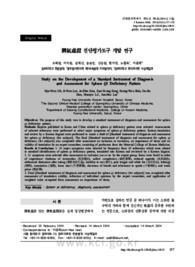

PARTNER
검증된 파트너 제휴사 자료
脾氣虛證 진단평가도구 개발 연구 (Study on the Development of a Standard Instrument of Diagnosis and Assessment for Spleen Qi Deficiency Pattern)
14 페이지
최초등록일 2025.05.16
최종저작일
2014.03

-
미리보기
서지정보
· 발행기관 : 대한한의학회
· 수록지 정보 : 대한한의학회지 / 35권 / 1호 / 157 ~ 170페이지
· 저자명 : 오혜원, 이지원, 김제신, 송은영, 신승원, 한가진, 노환옥, 이준희
초록
Objectives: The purpose of this study was to develop a standard instrument of diagnosis and assessment for spleen qi deficiency pattern.
Methods: Reports published in Korea and China related to spleen qi deficiency pattern were selected. Assessments of selected references were performed to select major symptoms of spleen qi deficiency pattern. Korean translation and review by a Korean linguist were performed to create a draft of [Standard instrument of diagnosis and assessment for spleen qi deficiency (for subject)]. The final [Standard instrument of diagnosis and assessment for spleen qi deficiency (for subject)] was completed after assessment on inclusion or exclusion, on importance of items and on validity of translation by an expert committee, consisting of professors from the National College of Korean Medicine.
Results & Conclusions: 1. 14 major symptoms were selected by frequency from 45 references which were related to standard identification of spleen qi deficiency pattern, translated into Korean and reviewed by a Korean linguist.
2. 11 symptoms were selected after assessment on inclusion yes or no by the expert group. Items were listed in order of importance: tiredness of extremities (肢体倦怠), sallow complexion (面色萎黄), reduced appetite (食欲减退), abdominal distension after eating (腹胀食後尤甚), inability to eat (納少), pale tongue and white fur (舌淡苔白), lethargy (神疲), emaciation (消瘦), loose stool (大便溏薄), shortness of breath and reluctance to speak (少氣懶言), and weak pulse (脈緩弱).
3. Final [Standard instrument of diagnosis and assessment for spleen qi deficiency (for subject)] was completed after assessment of translation validity, reflection of individual opinions by the expert committee, and application of weighted value computed from assessment on importance of items.영어초록
Objectives: The purpose of this study was to develop a standard instrument of diagnosis and assessment for spleen qi deficiency pattern.
Methods: Reports published in Korea and China related to spleen qi deficiency pattern were selected. Assessments of selected references were performed to select major symptoms of spleen qi deficiency pattern. Korean translation and review by a Korean linguist were performed to create a draft of [Standard instrument of diagnosis and assessment for spleen qi deficiency (for subject)]. The final [Standard instrument of diagnosis and assessment for spleen qi deficiency (for subject)] was completed after assessment on inclusion or exclusion, on importance of items and on validity of translation by an expert committee, consisting of professors from the National College of Korean Medicine.
Results & Conclusions: 1. 14 major symptoms were selected by frequency from 45 references which were related to standard identification of spleen qi deficiency pattern, translated into Korean and reviewed by a Korean linguist.
2. 11 symptoms were selected after assessment on inclusion yes or no by the expert group. Items were listed in order of importance: tiredness of extremities (肢体倦怠), sallow complexion (面色萎黄), reduced appetite (食欲减退), abdominal distension after eating (腹胀食後尤甚), inability to eat (納少), pale tongue and white fur (舌淡苔白), lethargy (神疲), emaciation (消瘦), loose stool (大便溏薄), shortness of breath and reluctance to speak (少氣懶言), and weak pulse (脈緩弱).
3. Final [Standard instrument of diagnosis and assessment for spleen qi deficiency (for subject)] was completed after assessment of translation validity, reflection of individual opinions by the expert committee, and application of weighted value computed from assessment on importance of items.참고자료
· 없음태그
-
자주묻는질문의 답변을 확인해 주세요

꼭 알아주세요
-
자료의 정보 및 내용의 진실성에 대하여 해피캠퍼스는 보증하지 않으며, 해당 정보 및 게시물 저작권과 기타 법적 책임은 자료 등록자에게 있습니다.
자료 및 게시물 내용의 불법적 이용, 무단 전재∙배포는 금지되어 있습니다.
저작권침해, 명예훼손 등 분쟁 요소 발견 시 고객센터의 저작권침해 신고센터를 이용해 주시기 바랍니다. -
해피캠퍼스는 구매자와 판매자 모두가 만족하는 서비스가 되도록 노력하고 있으며, 아래의 4가지 자료환불 조건을 꼭 확인해주시기 바랍니다.
파일오류 중복자료 저작권 없음 설명과 실제 내용 불일치 파일의 다운로드가 제대로 되지 않거나 파일형식에 맞는 프로그램으로 정상 작동하지 않는 경우 다른 자료와 70% 이상 내용이 일치하는 경우 (중복임을 확인할 수 있는 근거 필요함) 인터넷의 다른 사이트, 연구기관, 학교, 서적 등의 자료를 도용한 경우 자료의 설명과 실제 자료의 내용이 일치하지 않는 경우
“대한한의학회지”의 다른 논문도 확인해 보세요!
-
중년 건강검진 수진자에서 대사증후군과 한방비만변증의 관련성 11 페이지
Objectives: Metabolic syndrome is considered a coronary heart disease risk factor and its prevalence rate is increasing in Korea. Because obesity is relevant to metabolic syndrome, we investigated the.. -
灸(쑥뜸)시술행위의 개선을 위한 藥灸劑의 활용 15 페이지
To provide theoretical basis for the classification of medicinal moxibustion(藥灸劑) in Health Insurance Medical Benefit in Korea through investigating trend of judicial precedents on indirect moxibustio.. -
성장기 소아청소년들의 이차성징에 따른 진맥시 맥박변화와 골연령, 역연령, 키, 체중 등의 상관성 연구 11 페이지
Objectives: The purpose of this study is to investigate the relationship between bone age, chronological age, anthropometric parameters, and diagnosed pulse rate on child-adolescence's growth accordin.. -
한국의 건강기능식품 시장의 성장과 한의계의 대응전략 7 페이지
Objectives: To analyze the growth pattern of the functional food market in Korea, and thus produce essential information in mapping out a strategy for Korean medicine. Methods: A survey of literature ..
문서 초안을 생성해주는 EasyAI
